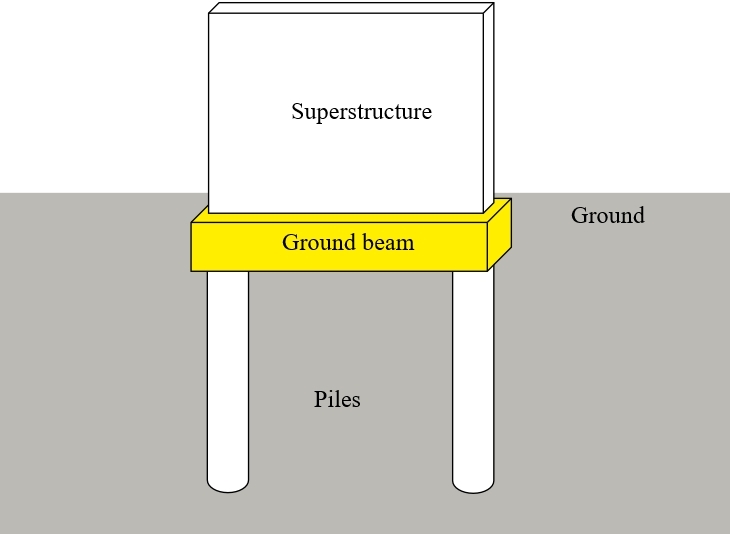Ground beams in construction
Beams are structural elements that transfer loads imposed along their length to their end points where the loads are transferred to walls, columns, foundations, and so on.
Ground beams are beams that are designed to span between pad foundations, piles and so on, as an alternative to traditional foundations.

|
Ground beams are generally constructed from concrete, and for low-rise buildings are commonly constructed in situ, however, as this can be relatively time-consuming method, the use of precast concrete ground beams has increased.
The advantages of using ground beams are that they are quicker to install than conventional footings, and allow uncertainties regarding ground conditions to be overcome. They also create a very accurate bearing level, reducing the amount of levelling up that is required prior to starting to build up the superstructure.
Ground beams may be used to support brick work, block work and so on, but may also be used at the edge of in situ concrete floor slabs, where they form permanent shuttering. They tend to be square or rectangular in section, and can be designed to incorporate notches, end details and sloping faces.
Precast ground beams are cast to the required lengths in an off-site factory and are then lowered into place on site, typically spanning between the tops of piles. Small in situ concrete ‘stitches’ are used to connect and bolt the beams securely to each other and the piles. Secondary beams can also be connected to the ground beam system to form a beam and block ground floor.
[edit] Find out more
[edit] Related articles on Designing Buildings Wiki
Featured articles and news
Government consultations for the summer of 2025
A year of Labour, past and present consultations on the environment, the built environment, training and tax.
CMA competitiveness probe of major housing developers
100 million affordable housing contributions committed with further consultation published.
Homes England supports Greencore Homes
42 new build affordable sustainable homes in Oxfordshire.
Zero carbon social housing: unlocking brownfield potential
Seven ZEDpod strategies for brownfield housing success.
CIOB report; a blueprint for SDGs and the built environment
Pairing the Sustainable Development Goals with projects.
Types, tests, standards and fires relating to external cladding
Brief descriptions with an extensive list of fires for review.
Latest Build UK Building Safety Regime explainer published
Key elements in one short, now updated document.
UKGBC launch the UK Climate Resilience Roadmap
First guidance of its kind on direct climate impacts for the built environment and how it can adapt.
CLC Health, Safety and Wellbeing Strategy 2025
Launched by the Minister for Industry to look at fatalities on site, improving mental health and other issues.
One of the most impressive Victorian architects. Book review.
Common Assessment Standard now with building safety
New CAS update now includes mandatory building safety questions.
RTPI leader to become new CIOB Chief Executive Officer
Dr Victoria Hills MRTPI, FICE to take over after Caroline Gumble’s departure.
Social and affordable housing, a long term plan for delivery
The “Delivering a Decade of Renewal for Social and Affordable Housing” strategy sets out future path.
A change to adoptive architecture
Effects of global weather warming on architectural detailing, material choice and human interaction.
The proposed publicly owned and backed subsidiary of Homes England, to facilitate new homes.
How big is the problem and what can we do to mitigate the effects?
Overheating guidance and tools for building designers
A number of cool guides to help with the heat.
The UK's Modern Industrial Strategy: A 10 year plan
Previous consultation criticism, current key elements and general support with some persisting reservations.
Building Safety Regulator reforms
New roles, new staff and a new fast track service pave the way for a single construction regulator.
























